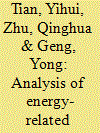|
|
|
Sort Order |
|
|
|
Items / Page
|
|
|
|
|
|
|
| Srl | Item |
| 1 |
ID:
121291


|
|
|
|
|
| Publication |
2013.
|
| Summary/Abstract |
With China's increasing pressures on reducing greenhouse gas (GHG) emission, Chinese iron and steel industry (ISI) is facing a great challenge. In this paper, we address the energy-related GHG emission trajectories, features, and driving forces in Chinese ISI for 2001-2010. First, energy related GHG inventory for ISI is made for both scope 1 (direct emissions) and scope 2 (including imported electricity emission). Then, the driving forces for such emission changes are explored by utilizing the method of logarithmic mean Divisa index (LMDI) decomposition analysis. Results indicate that Chinese ISI experienced a rapid growth of energy related GHG emission at average annual growth rate of 70 million tons CO2e. Production scale effect is the main driving factor for energy related GHG emission increase in Chinese ISI, while energy intensity effect and emission factor change effect offset the total increase and energy structure has marginal effect. Construction, manufacture of general purpose and special purpose machinery and manufacture of transport equipment sectors are main sectors for embodied emissions, amounting for more than 75% of the total embodied emissions from Chinese ISI. Such research findings propose that a detailed consideration can help make appropriate polices for mitigating ISI's energy-related GHG emission.
|
|
|
|
|
|
|
|
|
|
|
|
|
|
|
|
| 2 |
ID:
121365


|
|
|
|
|
| Publication |
2013.
|
| Summary/Abstract |
Industrial parks have become the effective strategies for government to promote sustainable economic development due to the following advantages: shared infrastructure and concentrated industrial activities within planned areas. However, due to intensive energy consumption and dependence on fossil fuels, industrial parks have become the main areas for greenhouse gas emissions. Therefore, it is critical to quantify their carbon footprints so that appropriate emission reduction policies can be raised. The objective of this paper is to seek an appropriate method on evaluating the carbon footprint of one industrial park. The tiered hybrid LCA method was selected due to its advantages over other methods. Shenyang Economic and Technological Development Zone (SETDZ), a typical comprehensive industrial park in China, was chosen as a case study park. The results show that the total life cycle carbon footprint of SETDZ was 15.29 Mt, including 6.81 Mt onsite (direct) carbon footprint, 8.47 Mt upstream carbon footprint, and only 3201 t downstream carbon footprint. Analysis from industrial sector perspectives shows that chemical industry and manufacture of general purpose machinery and special purposes machinery sector were the two largest sectors for life cycle carbon footprint. Such a sector analysis may be useful for investigation of appropriate emission reduction policies.
|
|
|
|
|
|
|
|
|
|
|
|
|
|
|
|
| 3 |
ID:
109630


|
|
|
|
|
| Publication |
2011.
|
| Summary/Abstract |
Cities consumed 84% of commercial energy in China, which indicates cities should be the main areas for GHG emissions reduction. Our case study of Shenyang in this paper shows how a clear inventory analysis on GHG emissions at city level can help to identify the major industries and societal sectors for reduction efforts so as to facilitate low-carbon policy-making. The results showed total carbon emission in 2007 was 57 Mt CO2 equivalents (CO2e), of which 41 Mt CO2e was in-boundary emissions and 16 Mt CO2e was out-of-boundary emissions. The energy sector was dominant in the emission inventory, accounting for 93.1% of total emissions. Within energy sector, emissions from energy production industry, manufacturing and construction industry accounted for 88.4% of this sector. Our analysis showed that comparing with geographical boundary, setting system boundary based on single process standard could provide better information to decision makers for carbon emission reduction. After attributing electricity and heating consumption to final users, the resident and commercial sector became the largest emitter, accounting for 28.5% of total emissions. Spatial analysis of emissions showed that industrial districts such as Shenbei and Tiexi had the large potential to reduce their carbon emissions. Implications of results are finally discussed.
|
|
|
|
|
|
|
|
|
|
|
|
|
|
|
|
| 4 |
ID:
115702


|
|
|
|
|
| Publication |
2012.
|
| Summary/Abstract |
As the world's top energy consumer, China is facing a great challenge to solve its energy supply issue. In this paper energy use from all industrial sectors in China's economy of 2007 was explored by conducting an extended environmental input-output analysis. We compare the energy consumption embodied in the final demand for goods and services from 29 sectors with the energy demand required for the actual production process in each sector. Two different viewpoints for sectoral energy use have been presented: energy use is directly allocated to the producer entity, and energy use is reallocated to sector's supply chain from consumption perspective. Our results show that considerable amount of energy use is embodied in the supply chain, especially for "Construction" and "Other Service Activities" sectors, which is not detected if energy use is allocated on a production basis. When further dividing embodied energy consumption into direct energy consumption and indirect energy consumption, total indirect energy consumption is much higher than that of total direct energy consumption, accounting for 80.6% of total embodied energy consumption in 2007. Our results provide a more holistic picture on sectoral energy consumption and therefore can help decision-makers make more appropriate policies.
|
|
|
|
|
|
|
|
|
|
|
|
|
|
|
|
| 5 |
ID:
137747


|
|
|
|
|
| Summary/Abstract |
Water and energy are important resources for regional economies and are inextricably and reciprocally linked. Global water and energy demand will increase significantly by 2030 while climate change will worsen water availability. Thus, it is important to ensure a sustainable energy supply despite the increasing severity of water resource constraints. Numerous studies have analyzed water requirements to produce energy from production perspectives. However, energy is generally supplied by both internal and external producers. Thus, it is necessary to consider the availability of water to produce energy from consumption perspectives also. We evaluate the water footprint of the energy supply of Liaoning Province, China. We apply the standard top-down approach using an input–output framework. We estimate the water footprint of the energy supply of Liaoning Province at 854 million m3 in 2002, with 47% of water used for electricity and heating. Our results reveal that energy supply could depend on water resources in neighboring provinces; external producers met 80% of the water footprint of energy supply, although only 35% of energy supply was imported. If Liaoning Province decreased its external dependency, withdrawal of available water resources within the province would increase from 86% to 91%. To guarantee future regional energy security, it is important to manage water resources effectively through water-efficient electricity generation and by allocating water resources among sectors.
|
|
|
|
|
|
|
|
|
|
|
|
|
|
|
|
| 6 |
ID:
124688


|
|
|
|
|
| Publication |
2013.
|
| Summary/Abstract |
In order to uncover driving forces for provincial CO2 emission in China, a case study was undertaken to shed light on the CO2 emission growth in such a region. Liaoning province was selected due to its typical features as one industrial province. The environmental input-output analysis and structure decomposing analysis have been conducted in order to provide a holistic picture on Liaoning's CO2 emissions during 1997-2007. Research outcomes indicate that rapid increase of per capita consumption activities is the main driver for Liaoning to have a significant CO2 emission growth, followed by consumption structure, production structure and population size. Energy intensity and energy structure partly offset the CO2 emission increase. Electricity power and heat supply and construction sectors caused the most CO2 emission, indicating that more specific mitigation policies for these two sectors should be prepared. From final demand point of view, it is clear that trade plays a leading role in regional CO2 emission, followed by fixed capital investment and urban household consumption which become increasingly important over time. Consequently, in order to realize low carbon development, local governments should consider all these factors so that appropriate mitigation policies can be raised by considering the local realities.
|
|
|
|
|
|
|
|
|
|
|
|
|
|
|
|
| 7 |
ID:
121381


|
|
|
|
|
| Publication |
2013.
|
| Summary/Abstract |
With ever growing urgency, climate change mitigation is fast becoming a priority for China. A successful policy of implementing and expanding sustainable development and the use of renewable energy is therefore vital. As well as long-term and near-term targets for installed capacity of renewable energy, in its 12th five-year plan, China has created strict and ambitious carbon intensity targets for each province. This study proposes an inter-provincial clean development mechanism to assist in meeting these targets. This mechanism will create potential co-benefits of assisting in sustainable development in lesser developed provinces, increasing local air quality and supporting the growth of China's renewable energy sector. This paper also highlights the potential that this inter-provincial clean development mechanism has in accelerating the growth of the domestic solar photovoltaics (PV) sector, for which the market in China is still in its infancy.
|
|
|
|
|
|
|
|
|
|
|
|
|
|
|
|
| 8 |
ID:
191153


|
|
|
|
|
| Summary/Abstract |
Previous studies focus on the direct impacts of environmental regulations while paying less attention to spillover effects. Taking the Eleventh Five-year Plan in China as a quasi-natural experiment, our results show that environmental regulations significantly increase the tax burden of unregulated firms. Environmental regulations generate spillover effects on firms that should not be subjected to regulatory policies. Further channel analysis shows that the fiscal pressure of local governments caused by environmental regulations is a major channel for the increase in the tax burden of unregulated firms. Finally, according to the heterogeneity results, the spillover effects are more pronounced in small firms, non-state-owned enterprises, and provinces with stricter enforcement. Our findings emphasize the additional costs of environmental policies, and the government should consider these costs when formulating policies.
|
|
|
|
|
|
|
|
|
|
|
|
|
|
|
|
|
|
|
|
|